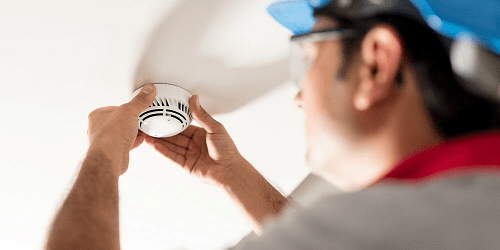
10.25.21- SSI
Fire/life-safety expert Shane Clary reviews the requirements and methods for testing smoke detector sensitivity per NFPA 72.
This month’s column is on a very sensitive topic … the testing of smoke detector sensitivity. All contractors who install and service fire alarm systems know that smoke detectors are required to be tested for the detection of the products of combustion or smoke.
This is a fairly easy test to conduct and the methods are covered within Chapter 14 of NFPA 72, National Fire Alarm and Signaling Code. There is also another test that is required, which is to test the sensitivity of smoke detectors.
A smoke detector over time will become dirty or be affected by other environmental factors to which it has been exposed. This may cause the detector to either become hypersensitive, which could lead to unwanted alarms, or desensitive, which may cause the detector not to operate when the products of combustion enter the sensing chamber of the detector.
The testing for smoke detector sensitivity has over the years become simpler to perform, and now in most cases, can be performed automatically by the fire alarm system. Back in the 1970s when I was a field technician, the sensitivity testing was very cumbersome and time-consuming.
The equipment that was required was also very expensive. As such, even though required by NFPA 72, this test was not performed that often, if at all, on the majority of installed systems.
The requirements and allowed methods for this test have remained stable over a number of cycles of NFPA 72. There is within 72 two key components of which to be aware:
- When to perform the test
- How to perform the test
When to perform the test can be a bit confusing and good record keeping is essential. The testing for sensitivity is in Section 14.4.4 Testing Frequency of the 2019 edition of 72. (As a sidenote, at the time that this column is being written, the NFPA Standards Council will be approving the release of the 2022 edition. The requirements for sensitivity testing remain the same.)
The testing frequency requirements begin with paragraph 14.4.4.3.1 and continue through 14.4.4.3.3. The standard also refers to the test as a calibration test. These are the same tests. The first test is to be performed within one year of the installation. There is no set time gap as to when this is to occur, so long as it is within one year of the installation of the detectors.
If the installation of the smoke detectors is at the time that the fire alarm system is installed, then the sensitivity test could be conducted at the time of the first annual inspection of the fire alarm system, so long as this occurs within one year.
Good recordkeeping is required if multiple detectors are installed as part of a tenant improvement (TI) that may not coincide with the date of the system installation. In this case, the first sensitivity test may occur before a full year has passed, with the tests being performed during the next annual inspection.Related:New Report Sheds Light on Residential Fire Statistics From Past 40 Years
The next required test is to be performed two years after the first. Once more, good recordkeeping is required if the occupancy has had a number of TIs that involve the installation of additional detectors. If all the detectors have a passing sensitivity test, then the next tests would be five years later. This is the maximum time allowed. You may still test every two years or even annually if you so choose.
If the decision is made to extend out to the maximum allowed time, then there needs to be in place a method to track unwanted alarms that may occur that are generated from the system’s smoke detectors. In those locations in which unwanted or nuisance alarms do occur, then those detectors would require a sensitivity or calibration test to be performed.
Any detector that is found to be outside of the listed range of the specific detector is either to be cleaned, recalibrated or replaced. While this is personal choice, I have found that replacing the detector has the best results in resolving the issue.
If the detector is found to be within the approved range for sensitivity and unwanted alarms are still occurring, then one should look at either the sensitivity range that the detectors may be set at, or the use of smoke detectors versus heat detectors within that area. Analog smoke detectors can have the sensitivity adjusted either up or down within an allowable range.
In these cases, there needs to be comprehensive records maintained to keep the required testing frequencies intact. These tests are not required for detector that are installed within one- and two-family dwellings. In next month’s column, I shall cover the methods that are permitted within NFPA 72 to conduct these test.
About the Author

SHANE CLARY, SSI Contributor
Shane Clary, Ph.D., is Security Sales & Integration’s “Fire Side Chat” columnist. He has more than 37 years of security and fire alarm industry experience. He serves on a number of NFPA technical committees, and is vice president of Codes and Standards Compliance for Pancheco, Calif.-based Bay Alarm Co.
